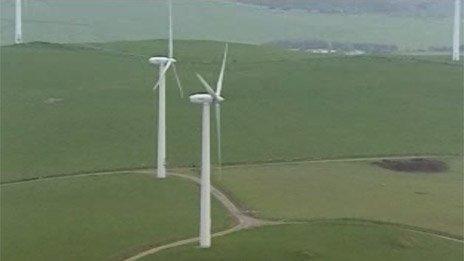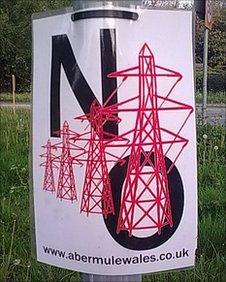Powys wind energy supporters say they face intimidation
- Published

The 23 applications for wind energy scheme would see almost 800 new turbines across mid Wales, many taller than those already there
Tension, intimidation, and local jealousies.
Those are some of the comments made as BBC Wales filmed a Taro Naw programme for S4C about the impact of energy developments such as wind farms and potentially 30 miles of pylons and power lines in mid Wales.
Plans to build 23 new wind farms and an infrastructure of pylons to support them are in danger of ripping some Montgomeryshire communities apart, say those who support the developments.
Taro Naw has spoken to several farmers and members of communities across Powys who say that the actions of protesters make them feel intimidated and afraid to attend meetings to voice their support for wind farms publicly.
Some local people are worried this ill-feeling will leave a long-term scar on communities.
"To put it simply - we feel intimidated. There's public confrontation in these meetings - and I can do without that in my life," said one farmer from Montgomeryshire, who appears in the programme anonymously.
"If you're not totally against wind power then people think you're bonkers.

Plans for pylons and substation led to a demo at the Senedd in Cardiff Bay
"We're scared to support any kind of alternative energy openly. I had a terrible experience at a public meeting in Meifod recently," says former head teacher Buddug Bates, from near Llanfaircaereinion.
Mrs Bates and her husband, the former AM Mick Bates, both support wind energy.
There are 23 applications for new wind farms in mid Wales. Currently, there are seven operational wind sites with 267 turbines on them already.
If all the new developments are built, there would be almost 800 new turbines - most are likely to be taller and bigger than the existing turbines.
This controversy started some 19 months ago when National Grid - which is legally obliged to carry electricity to where it is needed in Britain - published its consultation plans for a large power substation and 30 miles of pylons to be built in Montgomeryshire and Shropshire.
During May last year, 1,500 protesters gathered outside the Senedd in Cardiff Bay.
Groups such as Montgomeryshire Against Pylons have been active in battling the energy plans ever since. Its chair, dairy farmer Jonathan Wilkinson from Meifod, says direct action, as a last resort, cannot be ruled out.
He said: "If we fail in our ability to stop National Grid and stop this development then I'm pretty sure that public feeling is so strong that people will feel they have no other form of action."
The policy blamed by many is TAN 8. TAN stands for Technical Advice Note, and it's a planning document written by the Welsh government when First Minister Carwyn Jones was the environment minister in 2005.
TAN 8 established seven strategic areas thought to be suitable as sites for developing wind energy on a large scale. Three of those areas are in mid Wales.

Buddug Bates says she and her husband are scared to openly support wind energy plans
Mr Jones declined to be interviewed for the programme.
Taro Naw also spoke to several former planning officers who were part of the consultation in 2005 and several pointed out the flaws of the policy, especially in transport, connecting wind farms to the grid and environmental impacts.
One former planning officer said many felt there was a lack of consultation by the Welsh government during the writing of TAN 8.
Iwan Evans, a former planning officer with Gwynedd council, remembered the Welsh government pushing it through at speed.
"There was consultation, but I'm not sure how much notice was given to comments made during consultation. The final version of TAN 8 wasn't very different to the draft version, " said Mr Evans.
Pressure groups continue to oppose developments in Powys.
Meanwhile, those who support them fear their anger will have a long lasting effect on communities across the county.
- Published27 June 2012
- Published8 December 2011
- Published24 May 2011
- Published16 June 2011
- Published21 September 2011
- Published22 June 2011
- Published4 June 2010